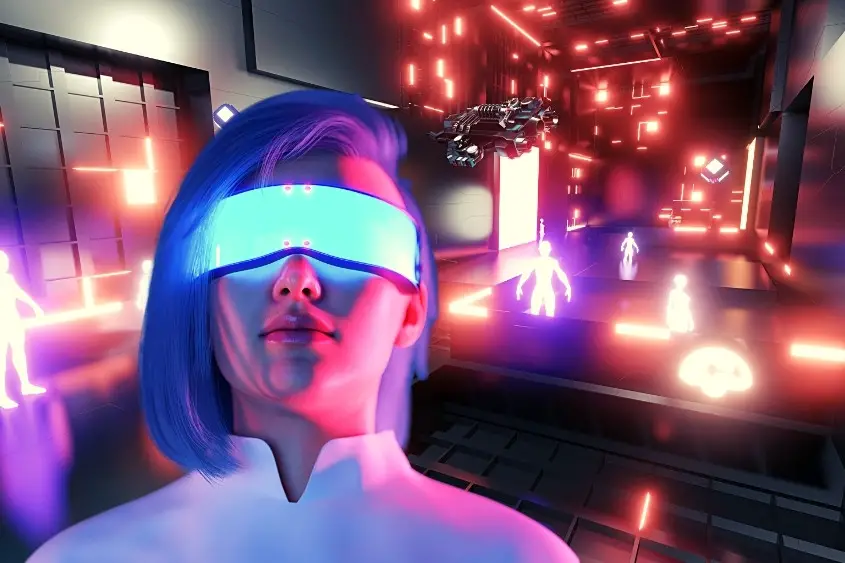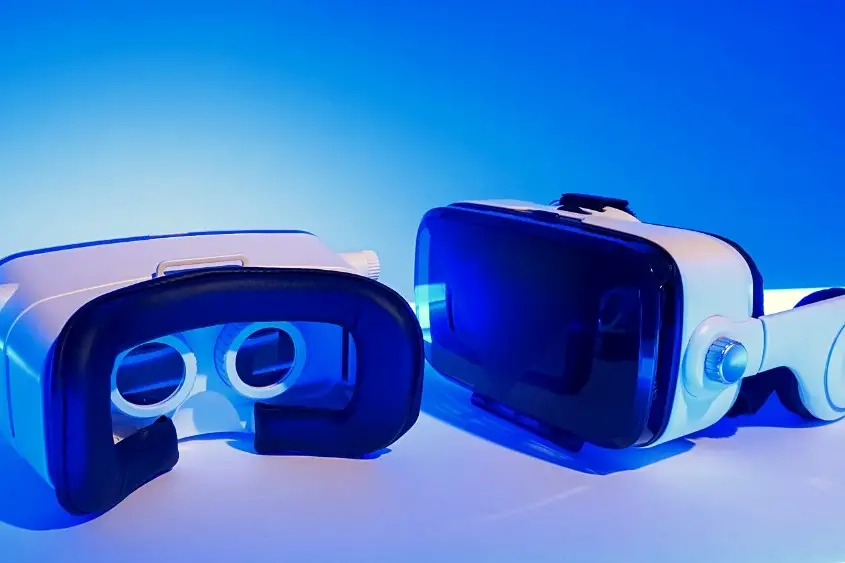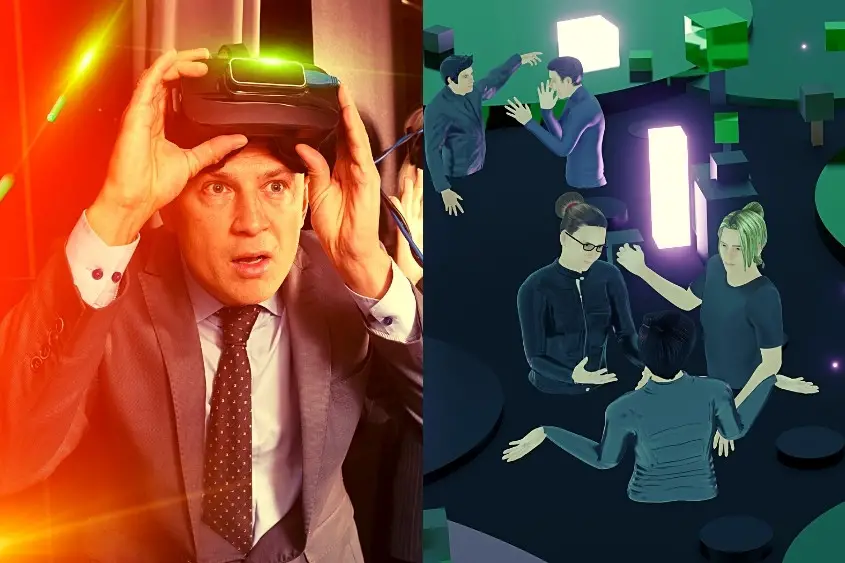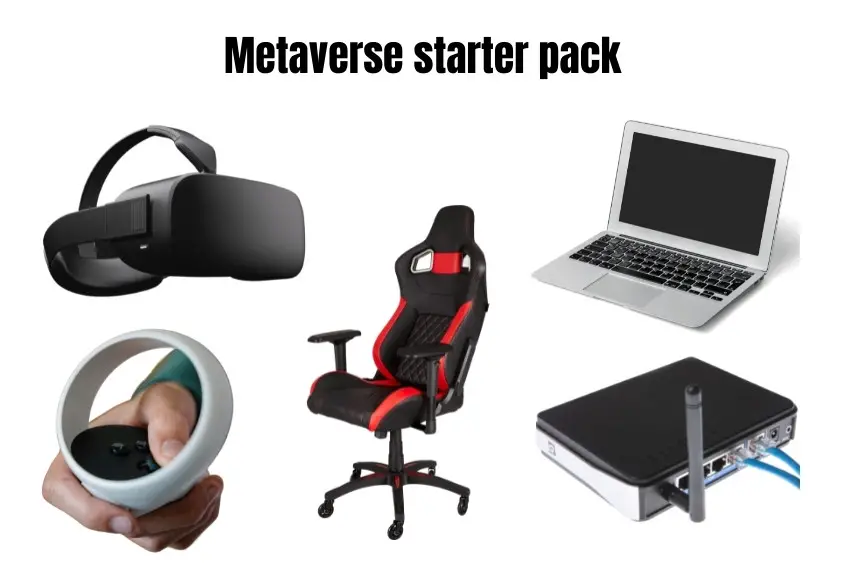Virtual reality and metaverse are two terms that are used casually these days. But what is the difference between the two?
The metaverse is a universal and immersive collection of virtual 3D worlds. Similar to the real world you can buy, sell, and create your own assets and experiences. Virtual reality is a technology used to simulate a 3D environment that can be interacted with by the user via hardware like goggles.
Although the metaverse and virtual reality are two different technologies, they both go hand in hand. Below you will learn what the main differences are between the two and how they work together.
What Is the Metaverse?
According to the Multidisciplinary Digital Publishing Institute (MDPI), the metaverse is a post-reality universe, containing a multiuser environment that merges physical reality with virtuality.

The easiest way to describe the metaverse is an immersive, 3D environment, that acts similar to the real world. You exist in the metaverse as an avatar (a virtual representation of yourself).
Using your avatar you can explore these virtual worlds. Just like in the real world, you can buy virtual products for your avatar as well as physical goods like clothing for yourself. Additionally, you can enjoy virtual experiences such as games, classes, concerts, and conferences.
It doesn’t stop there though.
You can also create your own virtual goods and experiences and monetize your creations to earn real money.
That being said, there isn’t a standardized currency that is used in the metaverse. However, all metaverses utilize some form of cryptocurrency. Considering the metaverse is made up of numerous virtual worlds, the type of crypto used depends on which metaverse you’re in.
Some of the most common cryptocurrencies used in the metaverse include ETH, SAND, and APE. As new virtual worlds arise, new currencies will likely appear as well.
It might seem obvious, but I believe it’s important to note that the metaverse makes things that are impossible in the real world, possible. Teleportation, flying, and the ability to build things insanely fast make the metaverse a true dreamland.
And if you think the metaverse is just one big game, you’re right. But it’s also much more than that. The metaverse has the potential to revolutionize every industry and change our lives as we know them today.
Believe it or not, big-name brands like Nike, Adidas, Sony, and Atari have already begun bridging their empires into the metaverse, having opened up virtual locations and even creating their own digital goods.
Some of the most popular metaverse worlds include The Sandbox, Decentraland, Cryptovoxels, Somnium Space, WorldWide Webb, and Otherside.
What Is Virtual Reality (VR)?
Morton Heilig introduced the first virtual reality machine in 1956, about 40 years before the term metaverse was coined by Neal Stephenson in his 1992 novel, Snow Crash.

That being said, I believe virtual reality has best been described by authors from the Department of Mechanical Engineering at the University of Hong Kong:
“Virtual reality (VR) is an advanced, human-computer interface that simulates a realistic environment. The participants can move around in the virtual world. They can see it from different angles, reach into it, grab it and reshape it.”
Although this description was written in 1998, I think it paints a clear picture of what virtual reality actually is, and how it differs from the metaverse.
In essence, virtual reality is simply a device that is used to display a 3D experience to users—similar to how your phone displays videos and other media. Of course, phones aren’t immersive like VR tech is.
As a result, virtual reality technology isn’t as optimized or nearly as popular as mobile devices like your phone—at least not yet. Most virtual reality devices utilize bulky headsets for displaying 3D experiences and handheld controllers used for functionality.
That being said, VR technology has come a long way in terms of user-friendliness and affordability. In fact, the best virtual reality headset, the Meta Oculus Quest 2, is only $299. That’s cheaper than most gaming systems and mobile phones.
Furthermore, VR headset unit sales have been on the rise since 2020, with an estimated total of more than 16 million units purchased to date. By 2024, the cumulative purchase of VR headsets is expected to surpass 34 million units.
Though VR headsets may be unattractive and clunky today, virtual-focused brands like Meta are already developing the VR units of tomorrow. That’s right. We won’t be wearing goggles for much longer.
The future of VR units will look a lot more like normal glasses. They’ll be lightweight, comfortable, and more efficient than today’s most popular options. But until then, you can still enjoy everything that the current technology has to offer.
With more than 200 immersive games to choose from on the Meta Oculus Quest alone—along with the ability to connect to the most popular metaverse worlds—virtual reality headsets are still worth trying if you haven’t already.
What Are the Main Differences Between VR and the Metaverse?
Now that you have a clear understanding of the metaverse and virtual reality technology, let’s discuss the main differences between the two.
| MetaverseVirtual Reality (VR)The metaverse is a location on the internet. | Virtual reality is a device that displays 3D environments. |
|---|---|
| The metaverse is a universal experience that exists with or without VR technology. | To experience virtual reality you must utilize a device. |
| The metaverse is a worldwide community that exists no matter what. Even when you log off, the metaverse is still active. | Virtual reality only exists when you are wearing a device. Once you power off the device, your virtual world disappears until you turn it back on. |
| In combination with blockchain technology, the metaverse enables users full ownership of their digital assets, identities, and experiences. | The ownership of virtual reality starts and stops with the device itself. There is no ownership beyond purchasing the device. |
1. The metaverse is a place, VR is a device
I like to think of the metaverse as a place that you visit and VR as a technology you can use to visit it. We don’t necessarily need one or the other for each technology to exist, however, they both compliment each other.

Again, I’ll use our phones as an example.
Our phone is a device. Using our phones, we visit various locations on the internet. These locations include social media, websites, and other apps.
You see, websites existed before mobile phones with internet capabilities existed. But, mobile phones existed before many popular websites of today existed. They both existed without each other, but they work even better when used together.
And this is the same case with the metaverse and virtual reality devices.
2. The metaverse is a universal experience, VR isn’t
The way you experience the metaverse compared to VR technology is also worth noting. In the metaverse, users can access a variety of different experiences in a shared space.
The metaverse exists with or without VR technology. But, the same can’t be said for VR. To access VR tech, you must wear a piece of hardware over your eyes.

With that, not every experience in the metaverse is a virtual reality experience because other technologies exist in the metaverse in addition to VR. AR and XR, for example, could be experienced as opposed to VR.
Moreover, the metaverse doesn’t have a limit on the number of people that can experience it in a single moment, whereas only people who have VR hardware can experience virtual reality.
Overall, the metaverse isn’t limited to a specific space per se, because so many different worlds exist within the metaverse. The metaverse enables users to visit and connect with other users and explore different spaces, despite not having access to VR.
3. The metaverse is active 24/7, VR ends once you turn it off
I’m not trying to get too technical, however, it is worth mentioning the difference in persistence of the metaverse compared to VR technology. Virtual reality ceases to exist the moment you take off your device and shut off the power.

As for the metaverse, it is always up and running. If you leave the metaverse your avatar will remain there along with all the data that is attached to your avatar. As well, whether there is one person using the metaverse or one million people, the metaverse is persistent in its functionality, VR is not.
4. The metaverse enables digital ownership, VR offers limited ownership
Considering the decentralized nature of the developing metaverse, users of the metaverse have complete ownership over their digital assets, avatars, and what they choose to experience all without the need for approval by any entity.
This freedom and full ownership open up an array of opportunities to those who are looking to express freedom of creativeness and potentially earn a real living doing so.
Obviously, when it comes to VR technology, ownership looks a bit different. Sure, you own the device once you purchase it, but that is as far as your ownership goes. You don’t have a say in what happens from there.
You simply put on your VR device and whatever is offered through that device is what you get. Nothing more, and nothing less.
Do You Need VR for the Metaverse?
You don’t need VR technology to access the metaverse. You only need an internet connection and a computer (or in some cases a phone) to access the metaverse. However, a VR device will enhance your experience by delivering an immersive display and enhanced functionalities via the controls.

That being said, as both metaverse and VR technology continue to advance the two technologies will work better than ever together.
Imagine when the internet first came out. People used large and inefficient computers to access a basic database. There were no mobile phones with internet access or even a laptop you could use.
Plus, the internet was insanely slow and inefficient and there weren’t many people using it at the time. They failed to see the bigger picture and lacked the patience that is required when it comes to exploring new realms of technology.
It is almost the exact same thing we are experiencing as a society today with the development of blockchain technology and the metaverse. Even some of the best VR devices used to explore the metaverse today, remind me of some of the earliest internet technologies.
But, that doesn’t mean the technology won’t get better. In fact, I know it will.
How to Enter the Metaverse
Entering the metaverse is easy. Simply follow these four steps below to get started.

1. Confirm you have the necessary components
You really don’t need much to enter many of the most popular metaverse worlds. As long as you have a decent computer and a strong internet connection, you can explore nearly any metaverse.
It’s important to note that some metaverse platforms might require you to have a web3 wallet such as Metamask to create an account and your avatar.
Your wallet is used as your digital identity. Also, it’s how you will buy and sell cryptocurrency and other digital assets you may acquire or create within a particular metaverse.
As well, if you have the means to purchase a virtual reality headset, I highly recommend you do. It will enhance your metaverse experience to unbelievable heights. Just make sure the metaverse you plan on exploring supports the VR device you get.
2. Choose a metaverse platform
There are numerous metaverse platforms to choose from and there will only be more to come as time progresses. As mentioned before, the most popular platforms include The Sandbox, Decentraland, Cryptovoxels, Somnium Space, WorldWide Webb, and Otherside.
I suggest exploring each one to determine which one is right for you. Choosing a metaverse ultimately comes down to your goals. Are you just looking to have fun? Or maybe you’re looking to create your own assets to earn a profit and monetize the experiences you create?
Once you determine what your goals are, you will have a much easier time deciding which metaverse is right for you.
3. Create your avatar
In most cases, creating your avatar is as easy as setting up an account. Generally, you will be required to enter a username and email address to get started. To reap the full benefits, some metaverse worlds may require you to have a web3 wallet to keep track of your digital identity.
If this seems foreign to you, I understand. However, it makes sense if you plan on owning any cryptocurrency or buying and selling digital assets. One of the most trusted wallets is Metamask.
4. Explore the world
After creating your avatar, get out there and explore the world. Most metaverses will have a map you can utilize for teleportation and basic travel purposes.
Furthermore, exploring the different worlds will allow you to get a hang of how each metaverse functions. There are different controls and options available depending on which metaverse you’re exploring.
The best way to learn is to do. Just remember, if you want to experience these virtual worlds to their fullest, you will likely need cryptocurrency. Crypto is often used to play games, attend concerts, and buy digital goods.
Don’t know which virtual world is right for you, or still have a lot of questions?
Then make sure to check out our complete beginner’s guide on how to enter the metaverse. This guide will show you everything you need to need in order to access the metaverse, costs, and even provides an overview of the most popular metaverse platforms currently available.
Which VR Devices Are Compatible With the Metaverse?
There are several popular VR devices that will allow you to experience the metaverse to the fullest. Below is a list of the most popular metaverses along with which VR headsets are compatible.
- Cryptovoxels: Oculus Quest 2, Oculus Rift, and HTC Vive.
- Somnium Space: Oculus Quest 2, HTC VIVE, HP, VALVE, all Windows Mixed Reality headsets, and other compatible major headsets.
- The Sandbox: HTC Vive, Oculus Rift+Touch, Oculus Quest 2, or Windows Mixed Reality.
- Roblox: Oculus Rift and Quest 2, HTC Vive, and Xbox control schemes.
Two of the most popular VR headsets include the Meta Oculus Quest 2 and the Valve Index, both of which are solid options.
However, If you’re looking for the most versatile and affordable VR headset for the metaverse specifically, I recommend the Meta Oculus Quest 2. This headset is the most accepted headset in the metaverse and gaming space.
Ultimately, the metaverse and virtual reality are two completely separate technologies. The metaverse is a platform similar to the internet, and VR is a device used to explore the metaverse, similar to using your phone or computer to explore platforms on the internet.
Although you don’t need the metaverse to use VR nor do you need VR to explore the metaverse, they work together to create the ultimate user experience.

1 thought on “What’s the Difference Between VR and the Metaverse?”
Comments are closed.